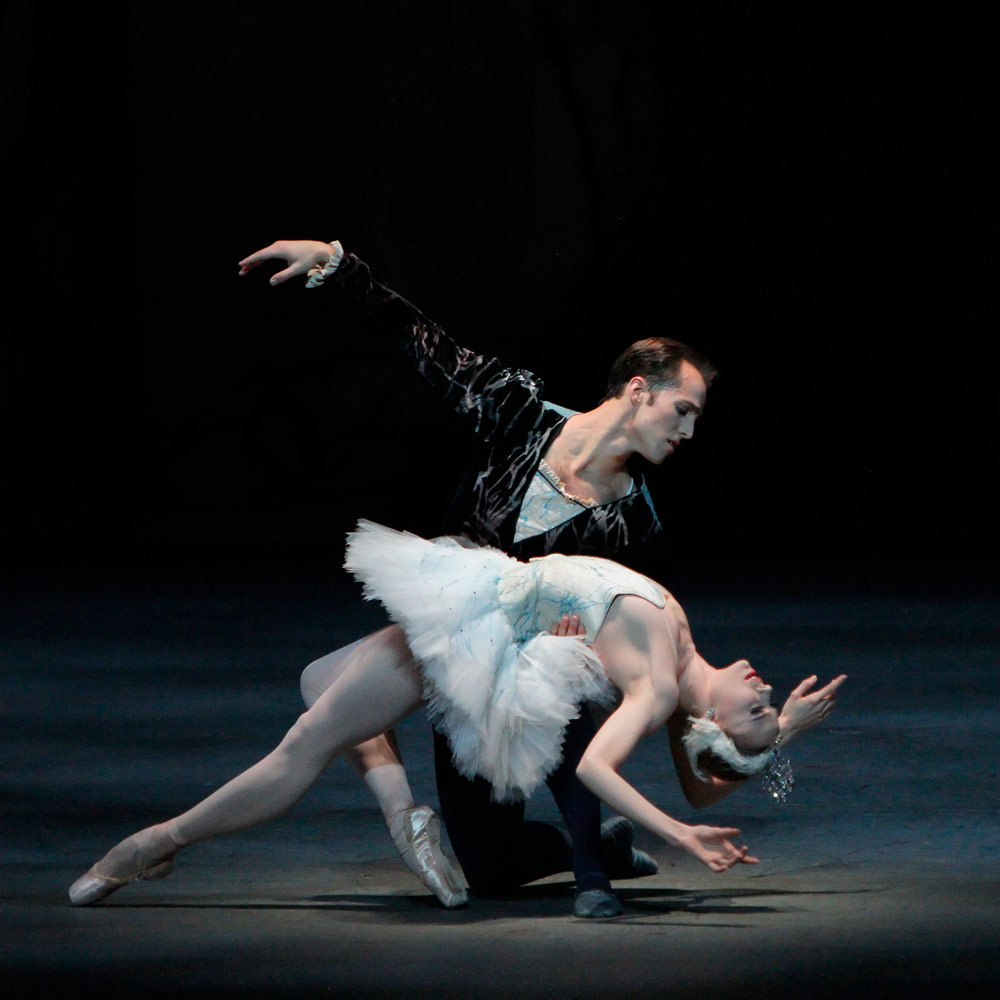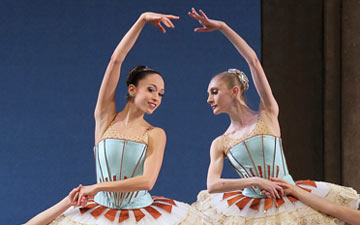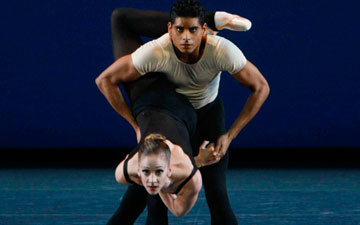
© Paul Kolnik. (Click image for larger version)
New York City Ballet
17, 20 Jan: La Sonnambula, Prodigal Son, Firebird
18 Jan: Allegro Brillante, Swan Lake, The Four Temperaments
★★★★✰
New York, David H. Koch Theater
17, 18, 20 January 2016
www.nycballet.com
davidhkochtheater.com
Back to Balanchine
Most seasons at New York City Ballet begin with a week of Balanchine ballets, and this one is no different. On opening night (Jan. 17), a triple bill of story ballets (La Sonnambula, Prodigal Son, Firebird) was a little jumpy. The tempi seemed rushed, there were some bleats from the orchestra, and more than one dancer slipped or faltered. There were high points too, the most heart-stopping of which was a rapt performance by Sterling Hyltin as the sleepwalker in La Sonnambula.
What made Hyltin’s sleepwalker so great? This 1946 one-act ballet is set at a masked ball at the home of a baron, during which his wife or mistress (she’s merely identified as “The Coquette”) flirts with a handsome poet. As soon as the guests retire for dinner, a mysterious sleepwalker descends from a turret and begins to glide across the stage, entrancing the poet. Hyltin danced with a stirring combination of force – particularly during her entrance, in which she runs across the stage on pointe – and disembodied lightness. At first she seemed propelled by a mysterious, almost desperate drive, as if searching for something (or someone) who had wronged her. Each stop caused her body to shudder, like a machine shifting gears. And her bourrées! As she wafted down the longest possible diagonal, her feet melted into a blur.
Later in the week (Jan. 20) Tiler Peck had her début in the role. It was fascinating to watch this famously capable ballerina – there is nothing she cannot do – take on a part that doesn’t really suit her prodigious talents. She’s too dynamic and in-control to appear disembodied. Try as she might, it was clearly Peck initiating the movement, never quite achieving the illusion of being driven by forces beyond her control. Her bourrées were fast, but lacked suppleness. No doubt she’ll work on them until they are just as she wants them to be. She’s that kind of dancer.
Of the two poets (Chase Finlay on Jan. 17 and Robert Fairchild on Jan. 20), Finlay was the one more suited to the role – more refined and dashing, though a little stiff in his bearing. Sara Mearns’s coquette was impetuous and conniving, Rebecca Krohn’s more vulnerable but also more bland. The little divertissements offered by the “entertainers” at the ball were well danced, particularly the pair in the exotique pas de deux – all flexed hands and acrobatic positions (Claire von Enck and Sebastian Villarini-Velez on Jan. 20).
The sets, by Alain Vaes, are rather dated and cartoony. And the costumes, with the exception of the sleepwalker’s gauzy nightdress, are tawdry-looking. The look of La Sonnambula could do with some sharpening, to make it more mysterious, less like something out of a child’s picture book. Little can be done about Vittorio Rieti’s trivializingly upbeat renditions of various melodies from Bellini operas. The most that can be said is that they support the choreography.

© Paul Kolnik. (Click image for larger version)
A note about the orchestra, which this week has played under the baton of New York City Ballet’s new music director, Andrew Litton. It is sounding better than it has in recent memory. One immediately notices the music’s increased presence in the hall. The sound is bold and crisp, with strong accents and contrasts of dynamics and texture. Litton draws out syncopations where one least expects them; the music feels less square, more unexpected. (On the down side, the mistakes are also more audible!) No more mealy-sounding accompaniments, the bane of the ballet-going audience. The final bell-like chords in Stravinsky’s Firebird cut through with almost violent force. Litton favors quick tempi, sometimes too quick, sending dancers rushing after the beat, unable to complete movements. This happened in Allegro Brillante on Jan. 18, which was a tad breathless. The men, especially, looked like they were marking. But it’s exciting to hear the music being given equal importance – this repertory deserves it.
In addition to that fleet Allegro Brillante, led by an unflappable if sometimes slightly mannered Tiler Peck, Jan. 18 also included a performance of George Balanchine’s one-act Swan Lake. This version, which focuses on the lakeside scenes, is rarely performed, especially since the introduction of Peter Martins’ full-evening version, in 1999.

© Paul Kolnik. (Click image for larger version)
For some reason, the action takes place in winter, with a palette of chilly whites and grays, icicles glistening. The flock of swans is made up of a mix of white and black, clad in gorgeous, long tutus in a chic, 1920’s style (Alain Vaes again), cut short at the front and longer at the back. Balanchine’s swan ensembles are far more intricate than the usual fare, with weaving and intercrossing patterns, subdividing lines, swarming effects. He also used a large number of swans, 30 to be precise, flooding the stage with arms and legs, often in cross-hatched patterns. A particular highlight was Ashley Laracey’s pure, clarion dancing in the Pas de Neuf. All to the good, if, unfortunately, Balanchine also cut the mime, which leads to an aimless-looking passage at the moment when the mime would usually happen.
Sara Mearns, who made her name as Swan Queen at the age of nineteen, is still the most thrilling Odette around. Her dancing here is almost trance-like. She enters, eyes glistening, and instantly draws the viewer into her world. Hers is not a placid or victimized interpretation, but vital, strong, and veined with anxiety and need. She stresses the legato aspects of the choreography, but her particular legato is sustained by power, each rolling down from pointe an act of will. The impact of her dancing seems to radiate from her supple back and down her strong legs. When she submits to her love for the prince, her body radiates warmth, love. You can’t take your eyes off her. Only one small quibble: if she lowered her shoulders, the line of her neck and head would read more clearly.
Mearns’ prince was Jared Angle, a masterful and self-effacing partner whose own solo dancing lacked élan. The top ranks of men at New York City Ballet are looking a tad thin these days; it may be time to try out some soloists. It would be particularly intriguing to see someone new in Prodigal Son, performed this week by Daniel Ulbricht (boyish and enthusiastic) and Joaquin de Luz (antic and a little glib). Perhaps the company might try out one of the men who appeared in the roles of the Prodigal’s friends, Harrison Coll and Devon Alberda on Jan. 17 and Spartak Hoxha and Ghaleb Kayali on the 20th. I don’t remember the fight scene ever being quite so exciting. Hoxha proved his chops last season in a new work by his colleague Peter Walker, and Coll recently débuted in the role of the Nutcracker Cavalier.

© Paul Kolnik. (Click image for larger version)
Which brings us to Firebird, with its wondrous score and dream-like designs by Marc Chagall. Ashley Bouder, recently back from maternity leave, has returned to the title role (Jan. 20), which she dances with an almost aggressive streak. At one point she seemed so eager to escape the grasp of her partner, Prince Ivan (Zachary Catazaro), that she accidentally swatted away his hand with a great, resounding slap. Her interpretation of the magic bird is like that – a bit too sharp, too overpowering. But her musicality is so keen that it makes us hear the Stravinsky score all the more clearly. Teresa Reichlen (Jan. 17) takes a different approach, soft, dreamy, elusive. I’ve seen her dance the role more incisively, but her air of loneliness in the Berceuse never fails to make an impact.
Now, on to the new works! There are three this season: two by Justin Peck, including a new “sneaker” ballet (The Times are Racing) and a company début by the Swedish-born Pontus Lidberg.
Here’s a teaser of the Peck:

















You must be logged in to post a comment.